Retinal Vessel Flicker Light Responsiveness and Its Relation to Analysis Protocols and Static and Metabolic Data in Healthy Subjects
Abstract
1. Introduction
2. Materials and Methods
2.1. Retinal Vessel Imaging
2.2. Statistical Procedure
3. Results
3.1. Retinal Oximetry
3.2. Static Measurement Evaluation
3.3. Dynamic Flicker Light Responses
3.4. Correlation of Dynamic, Static, and Metabolic Data
4. Discussion
Author Contributions
Funding
Institutional Review Board Statement
Informed Consent Statement
Data Availability Statement
Acknowledgments
Conflicts of Interest
Abbreviations
| ADil | Arterial dilation |
| A-SO2 | Oxygen saturation of arterioles |
| A-V-SO2 | Arterio-venular difference |
| AVR | Arteriovenous ratio |
| CRA | Central retinal arteriolar equivalent |
| CRV | Central retinal venous equivalent |
| D-A | Retinal vessel diameter of arteries |
| D-V | Retinal vessel diameter of veins |
| DVA | Dynamic retinal vessel analysis |
| FL | Flicker light |
| IOP | Intraocular pressure |
| MAD | Mean arterial diameter |
| MVD | Mean venous diameter |
| OD | Optic disk |
| OEF | Oxygen extraction fraction |
| RFR | Retinal vessel flicker response |
| RO | Retinal vessel oximetry |
| RPE | Retinal pigment epithelium |
| RVA | Retinal Vessel Analyzer |
| ST | Superotemporal area |
| ST A | Arteriolar superotemporal area |
| ST V | Venous superotemporal area |
| StO2 | retinal tissue oxygenation |
| SVA | Static retinal vessel analysis |
| VDil | Venous dilation |
| V-SO2 | Oxygen saturation of venules |
References
- Klein, R.; Klein, B.E.; Knudtson, M.D. Subclinical atherosclerotic cardiovascular disease and early age-related macular degeneration in a multiracial cohort: The multiethnic study of atherosclerosis. Arch. Ophthalmol. 2007, 125, 534–543. [Google Scholar] [CrossRef] [PubMed]
- Wong, T.Y.; Klein, R.; Sharrett, A.R.; Manolio, T.A.; Hubbard, L.D.; Marino, E.K.; Kuller, L.; Burke, G.; Tracy, R.P.; Polak, J.F.; et al. The prevalence and risk factors of retinal microvascular abnormalities in older persons: The cardiovascular health study. Ophthalmology 2003, 110, 658–666. [Google Scholar] [CrossRef]
- Stanton, A.V.; Mullaney, P.; Mee, F.; O’Brien, E.T.; O’MalIey, K. A method of quantifying retinal microvascular alterations associated with blood pressure and age. J. Hypertens. 1995, 13, 41–48. [Google Scholar] [CrossRef] [PubMed]
- Nagel, E.; Vilser, D.; Fuhrmann, G.; Vilser, W.; Lang, G.E. Dilatation of large retinal vessels after increased intraocular pressure. Ophthalmologe 2000, 97, 742–747. [Google Scholar] [CrossRef]
- Blum, M.; Kubetschka, U.; Hunger-Dathe, W.; Bachmann, K.; Muller, U.A.; Strobel, J. Autoregulation of retinal arterioles in patients with diabetes mellitus and normal probands. Klin. Monatsbl. Augenheilkd 2000, 216, 40–44. [Google Scholar] [CrossRef]
- Dorner, G.T.; Garhofer, G.; Kiss, B.; Polska, E.; Polak, K.; Riva, C.E.; Schmetterer, L. Nitric oxide regulates retinal vascular tone in humans. Am. J. Physiol. Heart Circ. Physiol. 2003, 285, H631–H636. [Google Scholar] [CrossRef]
- Garhofer, G.; Zawinka, C.; Resch, H.; Kothy, P.; Schmetterer, L.; Dorner, G.T. Reduced response of retinal vessel diameters to flicker stimulation in patients with diabetes. Br. J. Ophthalmol. 2004, 88, 887–891. [Google Scholar] [CrossRef] [PubMed]
- Nagel, E.; Vilser, W.; Lanzl, I. Age, blood pressure, and vessel diameter as factors influencing the arterial retinal flicker response. Investig. Ophthalmol. Vis. Sci. 2004, 45, 1486–1492. [Google Scholar] [CrossRef]
- Leithner, C.; Royl, G. The Oxygen Paradox of Neurovascular Coupling. J. Cereb. Blood Flow Metab. 2014, 34, 19–29. [Google Scholar] [CrossRef]
- Saidha, S.; Al-Louzi, O.; Ratchford, J.N.; Bhargava, P.; Oh, J.; Newsome, S.D.; Prince, J.L.; Pham, D.; Roy, S.; van Zijl, P.; et al. Optical coherence tomography reflects brain atrophy in multiple sclerosis: A four-year study. Ann. Neurol. 2015, 78, 801–813. [Google Scholar] [CrossRef]
- Krantic, S.; Torriglia, A. Retina: Source of the earliest biomarkers for Alzheimer’s disease? J. Alzheimer’s Dis. 2014, 40, 237–243. [Google Scholar] [CrossRef] [PubMed]
- Leeson, P.; Thorne, S.; Donald, A.; Mullen, M.; Clarkson, P.; Deanfield, J. Non-invasive measurement of endothelial function: Effect on brachial artery dilation of graded endothelial dependent and independent stimuli. Heart 1997, 78, 22–27. [Google Scholar] [CrossRef] [PubMed]
- Chowienczyk, P.J.; Watts, G.F.; Cockcroft, J.R.; Ritter, J.M. Impaired endothelium-dependent vasodilation of forearm restistance vessels in hypercholesterolaemia. Lancet 1992, 340, 1430–1432. [Google Scholar] [CrossRef] [PubMed]
- Ikram, M.K.; Ong, Y.T.; Cheung, C.Y.; Wong, T.Y. Retinal vascular caliber measurements: Clinical significance, current knowledge and future perspectives. Ophthalmologica 2013, 229, 125–136. [Google Scholar] [CrossRef]
- Wang, J.J.; Liew, G.; Klein, R.; Rochtchina, E.; Knudtson, M.D.; Klein, B.E.; Wong, T.Y.; Burlutsky, G.; Mitchell, P. Retinal vessel diameter and cardiovascular mortality: Pooled data analysis from two older populations. Eur. Heart J. 2007, 28, 1984–1992. [Google Scholar] [CrossRef]
- Witt, N.; Wong, T.Y.; Hughes, A.D.; Chaturvedi, N.; Klein, B.E.; Evans, R.; McNamara, M.; Thom, S.A.M.; Klein, R. Abnormalities of retinal microvascular structure and risk of mortality from ischemic heart disease and stroke. Hypertension 2006, 47, 975–981. [Google Scholar] [CrossRef]
- Wong, T.Y.; Klein, R.; Couper, D.J.; Cooper, L.S.; Shahar, E.; Hubbard, L.D.; Wofford, M.R.; Sharrett, A.R. Retinal microvascular abnormalities and incident stroke: The Atherosclerosis Risk in Communities Study. Lancet 2001, 358, 1134–1140. [Google Scholar] [CrossRef]
- Tedeschi-Reiner, E.; Strozzi, M.; Skoric, B.; Reiner, Z. Relation of atherosclerotic changes in retinal arteries to the extent of coronary artery disease. Am. J. Cardiol. 2005, 96, 1107–1109. [Google Scholar] [CrossRef]
- Deiseroth, A.; Marcin, T.; Berger, C.; Infanger, D.; Schäfer, J.; Bannert, B.; Schmidt-Trucksäss, A.; Voll, R.E.; Kyburz, D.; Hanssen, H. Retinal vessel diameters and physical activity in patients with mild to moderate rheumatic disease without cardiovascular comorbidities. Front. Physiol. 2018, 9, 176. [Google Scholar] [CrossRef]
- Vilser, W.; Riemer, T.; Münch, K.; Strobl, J. Automatic online measurement of retinal vessel diameters. Investig. Ophthalmol. Vis. Sci. 1996, 37, 226. [Google Scholar]
- Vilser, W.; Nagel, E.; Lanzl, I. Retinal Vessel Analysis-new possibilities. Biomed. Technol. 2002, 47 (Suppl. 1), S682–S685. [Google Scholar] [CrossRef] [PubMed]
- Vilser, W.; Klein, S.; Wulff, P.; Siegel, C.; Fuchs, G. Automated measurement of retinal vascular diameter. Fortschr. Ophthalmol. 1991, 88, 482–486. [Google Scholar] [PubMed]
- Riva, C.E.; Falsini, B.; Logean, E. Flicker-evoked responses of human optic nerve head blood flow: Luminance versus chromatic modulation. Investig. Ophthalmol. Vis. Sci. 2001, 42, 756–762. [Google Scholar]
- Riva, C.E.; Logean, E.; Falsini, B. Visually evoked hemodynamical response and assessment of neurovascular coupling in the optic nerve and retina. Prog. Retin. Eye Res. 2005, 24, 183–215. [Google Scholar] [CrossRef]
- Ito, H.; Takahashi, K.; Hatazawa, J.; Kim, S.G.; Kanno, I. Changes in human regional cerebral blood flow and cerebral blood volume during visual stimulation measured by positron emission tomography. J. Cereb. Blood Flow Metab. 2001, 21, 608–612. [Google Scholar] [CrossRef]
- Seifertl, B.U.; Vilser, W. Retinal Vessel Analyzer (RVA)-design and function. Biomed. Technol. 2002, 47 (Suppl. 1), 678–681. [Google Scholar] [CrossRef]
- Polak, K.; Dorner, G.; Kiss, B.; Polska, E.; Findl, O.; Rainer, G.; Eichler, H.-G.; Schmetterer, L. Evaluation of the Zeiss retinal vessel analyser. Br. J. Ophthalmol. 2000, 84, 1285–1290. [Google Scholar] [CrossRef]
- Jeppesen, P.; Gregersen, P.A.; Bek, T. The age-dependent decrease in the myogenic response of retinal arterioles as studied with the Retinal Vessel Analyzer. Graefe’s Arch. Clin. Exp. Ophthalmol. 2004, 242, 914–919. [Google Scholar] [CrossRef]
- Garhofer, G.; Bek, T.; Boehm, A.G.; Gherghel, D.; Grunwald, J.; Jeppesen, P.; Kergoat, H.; Kotliar, K.; Lanzl, I.; Lovasik, J.V.; et al. Use of the retinal vessel analyzer in ocular blood flow research. Acta Ophthalmol. 2010, 88, 717–722. [Google Scholar] [CrossRef]
- Dorner, G.T.; Garhöfer, G.; Huemer, K.H.; Riva, C.E.; Wolzt, M.; Schmetterer, L. Hyperglycemia affects flicker-induced vasodilation in the retina of healthy subjects. Vis. Res. 2003, 43, 1495–1500. [Google Scholar] [CrossRef]
- Gugleta, K.; Zawinka, C.; Rickenbacher, I.; Kochkorov, A.; Katamay, R.; Flammer, J.; Orgul, S. Analysis of retinal vasodilation after flicker light stimulation in relation to vasospastic propensity. Investig. Ophthalmol. Vis. Sci. 2006, 47, 4034–4041. [Google Scholar] [CrossRef] [PubMed]
- Nagel, E.; Vilser, W.; Fink, A.; Riemer, T.; Lanzl, I. Blood pressure effects on retinal vessel diameter and flicker response: A 1.5-year follow-up. Eur. J. Ophthalmol. 2006, 16, 560–565. [Google Scholar] [CrossRef]
- Heitmar, R.; Cubbidge, R.P.; Lip, G.Y.H.; Gherghel, D.; Blann, A.D. Altered blood vessel responses in the eye and finger in coronary artery disease. Investig. Ophthalmol. Vis. Sci. 2011, 52, 6199–6205. [Google Scholar] [CrossRef] [PubMed]
- Mandecka, A.; Dawczynski, J.; Blum, M.; Muller, N.; Kloos, C.; Wolf, G.; Vilser, W.; Hoyer, H.; Muller, U.A. Influence of flickering light on the retinal vessels in diabetic patients. Diabetes Care 2007, 30, 3048–3052. [Google Scholar] [CrossRef] [PubMed]
- Beach, J.M.; Schwenzer, K.J.; Srinivas, S.; Kim, D.; Tiedeman, J.S. Oximetry of retinal vessels by dual-wavelength imaging: Calibration and in- fluence of pigmentation. J. Appl. Physiol. 1999, 86, 748–758. [Google Scholar] [CrossRef]
- Bill, A.; Sperber, G.O. Aspects of oxygen and glucose consumption in the retina: Effects of high intraocular pressure and light. Graefe’s Arch. Clin. Exp. Ophthalmol. 1990, 228, 124–127. [Google Scholar] [CrossRef]
- Bill, A.; Sperber, G.O. Control of retinal and choroidal blood flow. Eye 1990, 4 Pt 2, 319–325. [Google Scholar] [CrossRef]
- Falsini, B.; Riva, C.E.; Logean, E. Flicker-evoked changes in human optic nerve blood flow: Relationship with retinal neural activity. Investig. Ophthalmol. Vis. Sci. 2002, 43, 2309–2316. [Google Scholar]
- Nagel, E.; Vilser, W. Flicker observation light induces diameter response in retinal arterioles: A clinical methodological study. Br. J. Ophthalmol. 2004, 88, 54–56. [Google Scholar] [CrossRef]
- Van Eijgen, J.; Van Winckel, L.; Hanssen, H.; Kotliar, K.; Vanassche, T.; Van Craenenbroeck, E.M.; Cornelissen, V.; Van Craenenbroeck, A.H.; Jones, E.; Stalmans, I. Retinal vessel analysis to assess microvascular function in the healthy eye: A systematic review on the response to acute physiological and pathological stressors. Surv. Ophthalmol. 2025, 70, 200–214. [Google Scholar] [CrossRef]
- Türksever, C.; Orgül, S.; Todorova, M.G. Reproducibility of retinal oximetry measurements in healthy and diseased retinas. Acta Ophthalmol. 2015, 93, e439–e445. [Google Scholar] [CrossRef] [PubMed]
- Hammer, M.; Vilser, W.; Riemer, T.; Schweitzer, D. Retinal vessel oximetry-calibration, compensation for vessel diameter and fundus pigmentation, and reproducibility. J. Biomed. Opt. 2008, 13, 054015. [Google Scholar] [CrossRef] [PubMed]
- Mućka, S.; Miodońska, M.; Jakubiak, G.K.; Starzak, M.; Cieślar, G.; Stanek, A. Endothelial Function Assessment by Flow-Mediated Dilation Method: A Valuable Tool in the Evaluation of the Cardiovascular System. Int. J. Environ. Res. Public Health 2022, 19, 11242. [Google Scholar] [CrossRef] [PubMed] [PubMed Central]
- Pache, M.; Nagel, E.; Flammer, J. Reproducibility of measurements with the retinal vessel analyser under optimal conditions. Klin. Monatsbl. Augenheilkd 2002, 219, 523–527. [Google Scholar] [CrossRef]
- Hammer, M.; Vilser, W.; Riemer, T.; Liemt, F.; Jentsch, S.; Dawczynski, J.; Schweitzer, D. Retinal venous oxygen saturation increases by flicker light stimulation. Investig. Ophthalmol. Vis. Sci. 2011, 52, 274–277. [Google Scholar] [CrossRef][Green Version]
- Sharifizad, M.; Witkowska, K.J.; Aschinger, G.C.; Sapeta, S.; Rauch, A.; Schmidl, D.; Werkmeister, R.M.; Garhöfer, G.; Schmetterer, L. Factors Determining Flicker-Induced Retinal Vasodilation in Healthy Subjects. Investig. Ophthalmol. Vis. Sci. 2016, 57, 3306–3312. [Google Scholar] [CrossRef] [PubMed]
- Pietscher, S.; Vilser, W.; Bachmann, K.; Riemer, T.H. The circadian relations between online-measured diameter of retinal vessel and blood pressure. Investig. Ophthalmol. Vis. Sci. 1997, 38, 4889. [Google Scholar]
- Streese, L.; Lona, G.; Wagner, J.; Knaier, R.; Burri, A.; Nève, G.; Infanger, D.; Vilser, W.; Schmidt-Trucksäss, A.; Hanssen, H. Normative data and standard operating procedures for static and dynamic retinal vessel analysis as biomarker for cardiovascular risk. Sci. Rep. 2021, 11, 14136. [Google Scholar] [CrossRef]
- Blair, N.P.; Wanek, J.; Felder, A.E.; Joslin, C.E.; Kresovich, J.K.; Lim, J.I.; Chau, F.Y.; Leiderman, Y.; Shahidi, M. Retinal Oximetry and Vessel Diameter Measurements With a Commercially Available Scanning Laser Ophthalmoscope in Diabetic Retinopathy. Investig. Ophthalmol. Vis. Sci. 2017, 58, 5556–5563. [Google Scholar] [CrossRef] [PubMed] [PubMed Central]
- Yang, Y.; Yang, D.; Sun, Y.; Xie, Y.; Zhang, Z.; Li, S.; Wu, S.; Wang, N. Retinal vessel oxygen saturation and vessel diameter in healthy individuals during high-altitude exposure. Acta Ophthalmol. 2019, 97, 279–286. [Google Scholar] [CrossRef] [PubMed]
- Felder, A.E.; Wanek, J.; Blair, N.P.; Shahidi, M. Inner Retinal Oxygen Extraction Fraction in Response to Light Flicker Stimulation in Humans. Investig. Opthalmology Vis. Sci. 2015, 56, 6633–6637. [Google Scholar] [CrossRef] [PubMed]
- Ito, H.; Kanno, I.; Kato, C.; Sasaki, T.; Ishii, K.; Ouchi, Y.; Iida, A.; Okazawa, H.; Hayashida, K.; Tsuyuguchi, N.; et al. Database of normal human cerebral blood flow, cerebral blood volume, cerebral oxygen extraction fraction and cerebral metabolic rate of oxygen measured by positron emission tomography with O-15-labelled carbon dioxide or water, carbon monoxide and oxygen: A multicentre study in Japan. Eur. J. Nucl. Med. Mol. Imaging 2004, 31, 635–643. [Google Scholar]
- Teng, P.Y.; Wanek, J.; Blair, N.P.; Shahidi, M. Inner retinal oxygen extraction fraction in rat. Investig. Ophthalmol. Vis. Sci. 2013, 54, 647–651. [Google Scholar] [CrossRef] [PubMed]
- Gupta, A.K.; Menon, D.K.; Czosnyka, M.; Smielewski, P.; Jones, J.G. Thresholds for hypoxic cerebral vasodilation in volunteers. Anesth. Analg. 1997, 85, 817–820. [Google Scholar] [CrossRef] [PubMed]
- Johnston, A.J.; Steiner, L.A.; Gupta, A.K.; Menon, D.K. Cerebral oxygen vasoreactivity and cerebral tissue oxygen reactivity. Br. J. Anaesth. 2003, 90, 774–786. [Google Scholar] [CrossRef] [PubMed]
- Newman, E.A. Functional hyperemia and mechanisms of neurovascular coupling in the retinal vasculature. J. Cereb. Blood Flow Metab. 2013, 33, 1685–1695. [Google Scholar] [CrossRef]
- Attwell, D.; Buchan, A.M.; Charpak, S.; Lauritzen, M.; Macvicar, B.A.; Newman, E.A. Glial and neuronal control of brain blood flow. Nature 2010, 468, 232–243. [Google Scholar] [CrossRef] [PubMed] [PubMed Central]
- Choudhary, T.R.; Ball, D.; Fernandez Ramos, J.; McNaught, A.I.; Harvey, A.R. Assessment of acute mild hypoxia on retinal oxygen saturation using snapshot retinal oximetry. Investig. Ophthalmol. Vis. Sci. 2013, 54, 7538–7543. [Google Scholar] [CrossRef] [PubMed]
- Bloch, W.; Mehlhorn, U.; Krahwinkel, A.; Reiner, M.; Dittrich, M.; Schmidt, A.; Addicks, K. Ischemia increases detectable endothelial nitric oxide synthase in rat and human myocardium. Nitric Oxide 2001, 5, 317–333. [Google Scholar] [CrossRef] [PubMed]
- Selvam, S.; Kumar, T.; Fruttiger, M. Retinal vasculature development in health and disease. Prog. Retin. Eye Res. 2018, 63, 1–19. [Google Scholar] [CrossRef] [PubMed]
- Luo, X.; Shen, Y.M.; Jiang, M.N.; Lou, X.F.; Shen, Y. Ocular Blood Flow Autoregulation Mechanisms and Methods. J. Ophthalmol. 2015, 2015, 864871. [Google Scholar] [CrossRef] [PubMed] [PubMed Central]
- Van Keer, K.; Breda, J.B.; Pinto, L.A.; Stalmans, I.; Vandewalle, E. Estimating Mean Ocular Perfusion Pressure Using Mean Arterial Pressure and Intraocular Pressure. Investig. Ophthalmol. Vis. Sci. 2016, 57, 2260. [Google Scholar] [CrossRef] [PubMed]
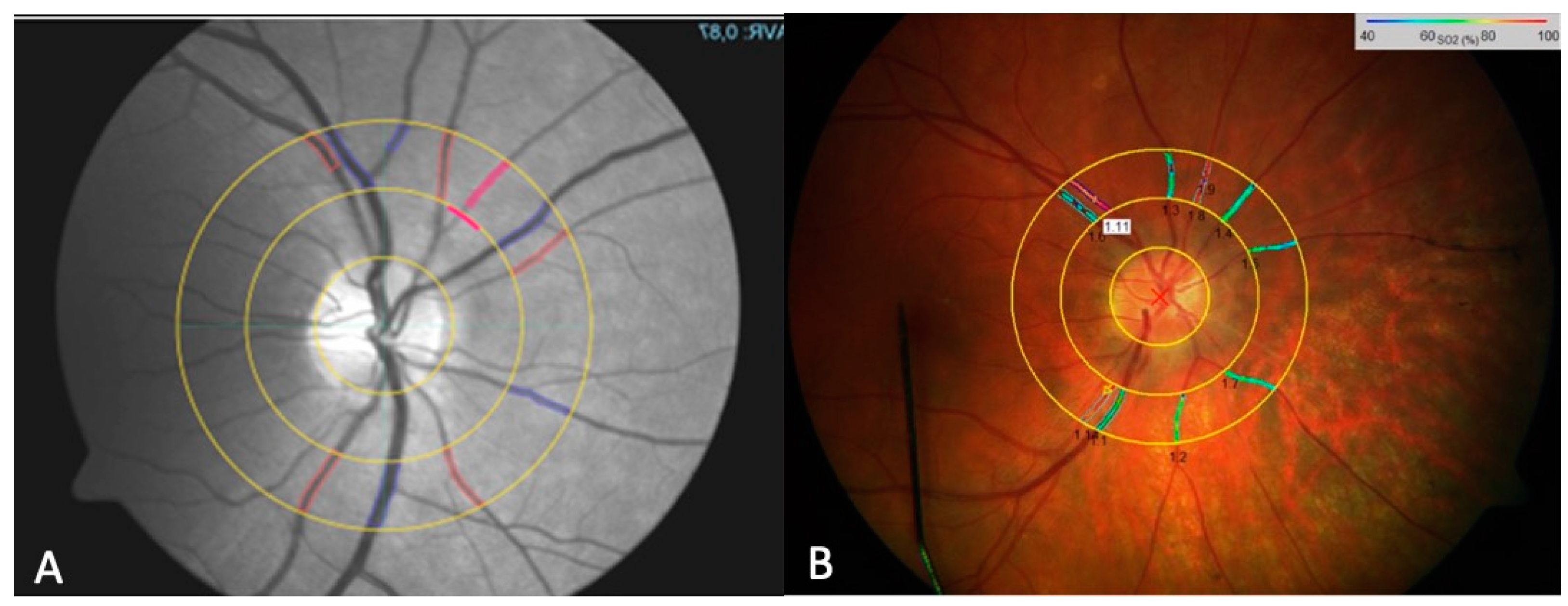
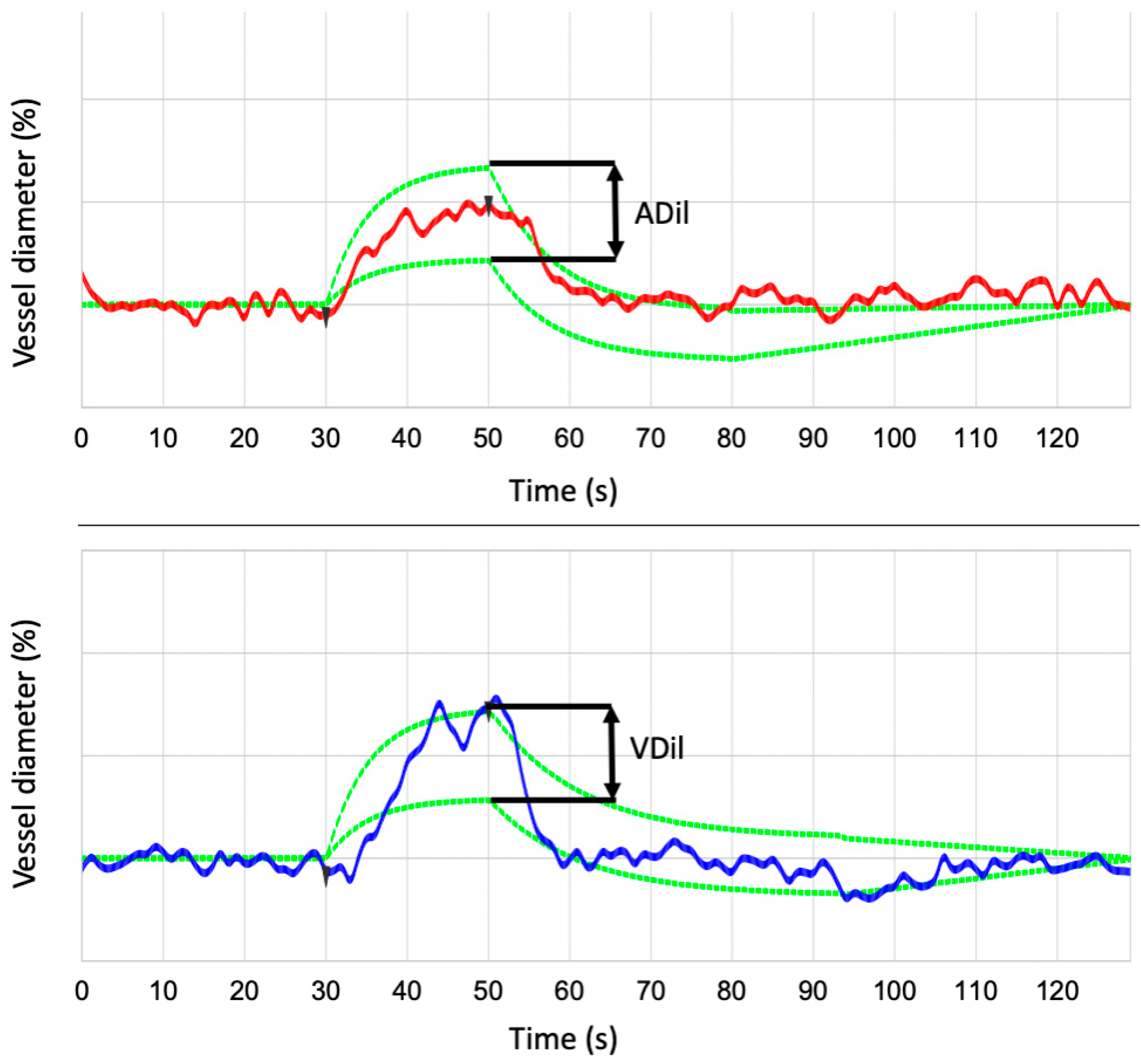

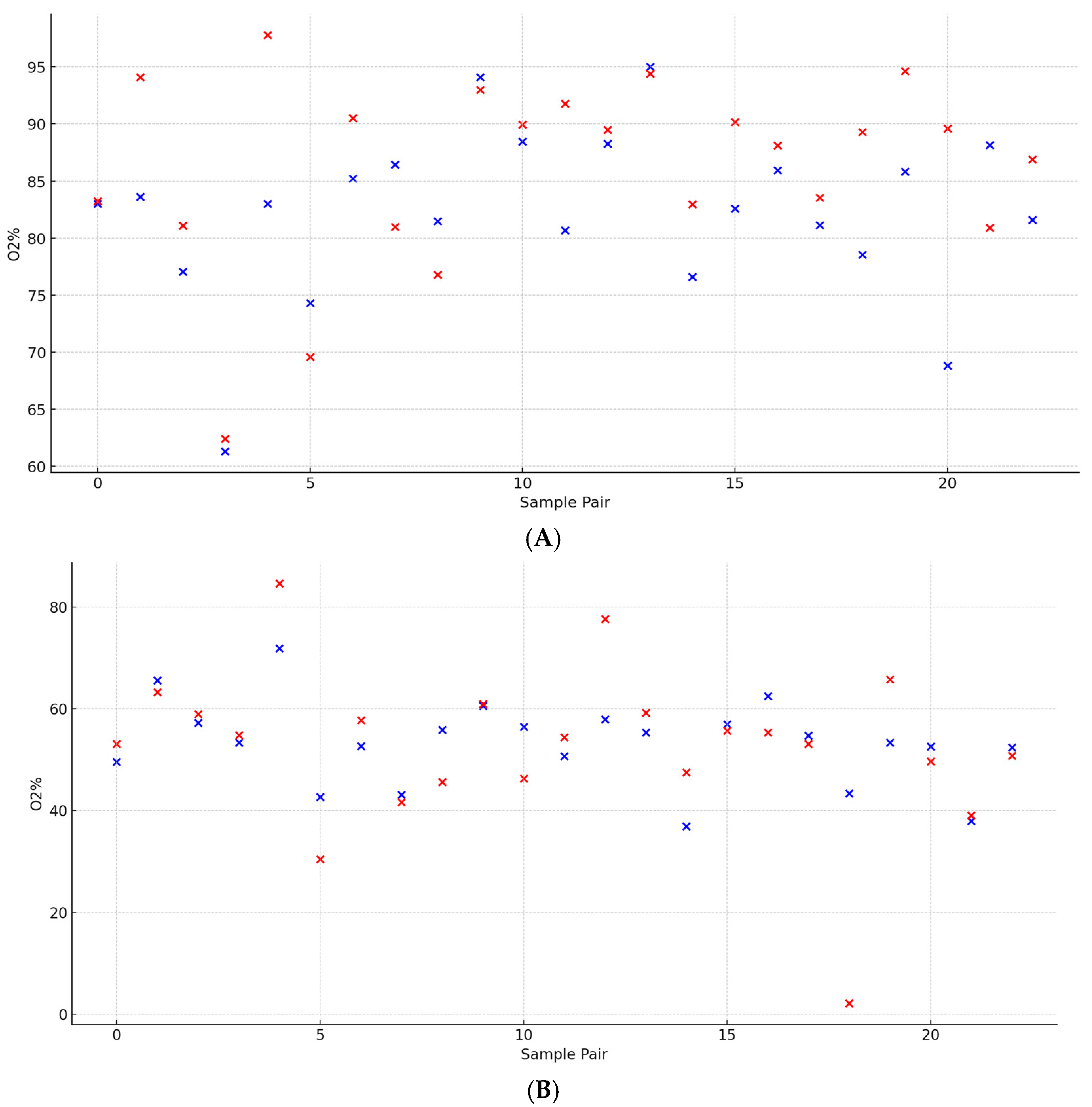

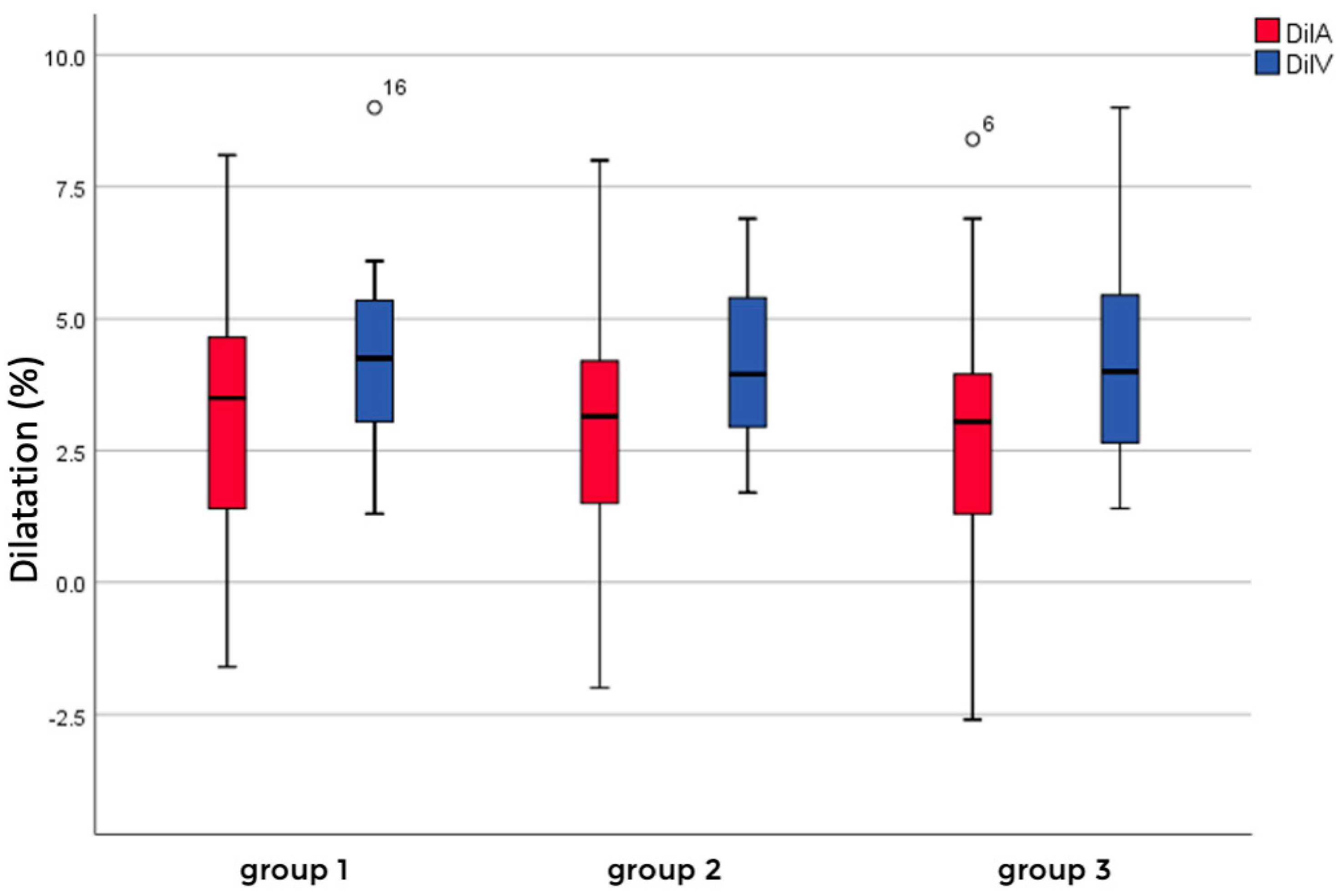
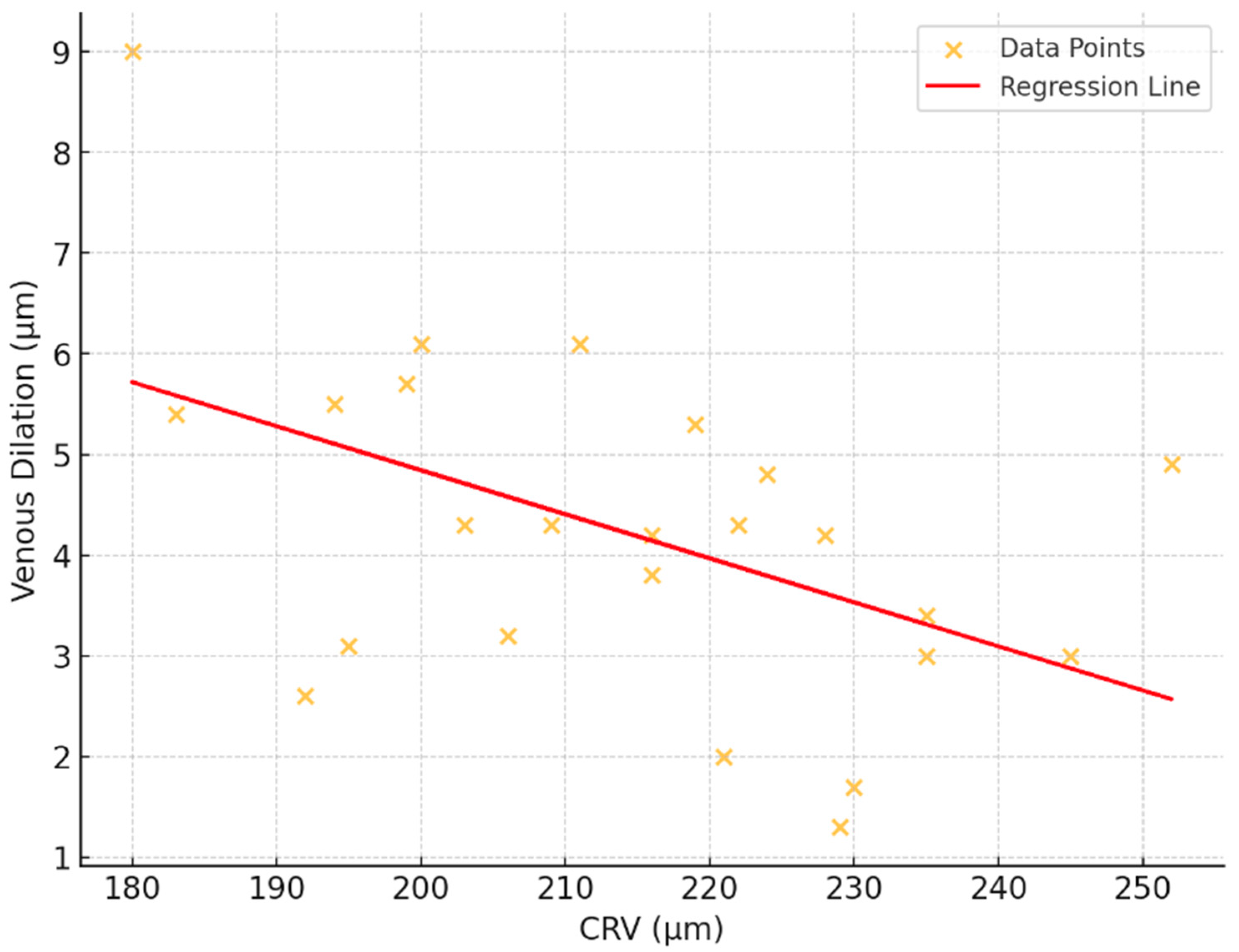
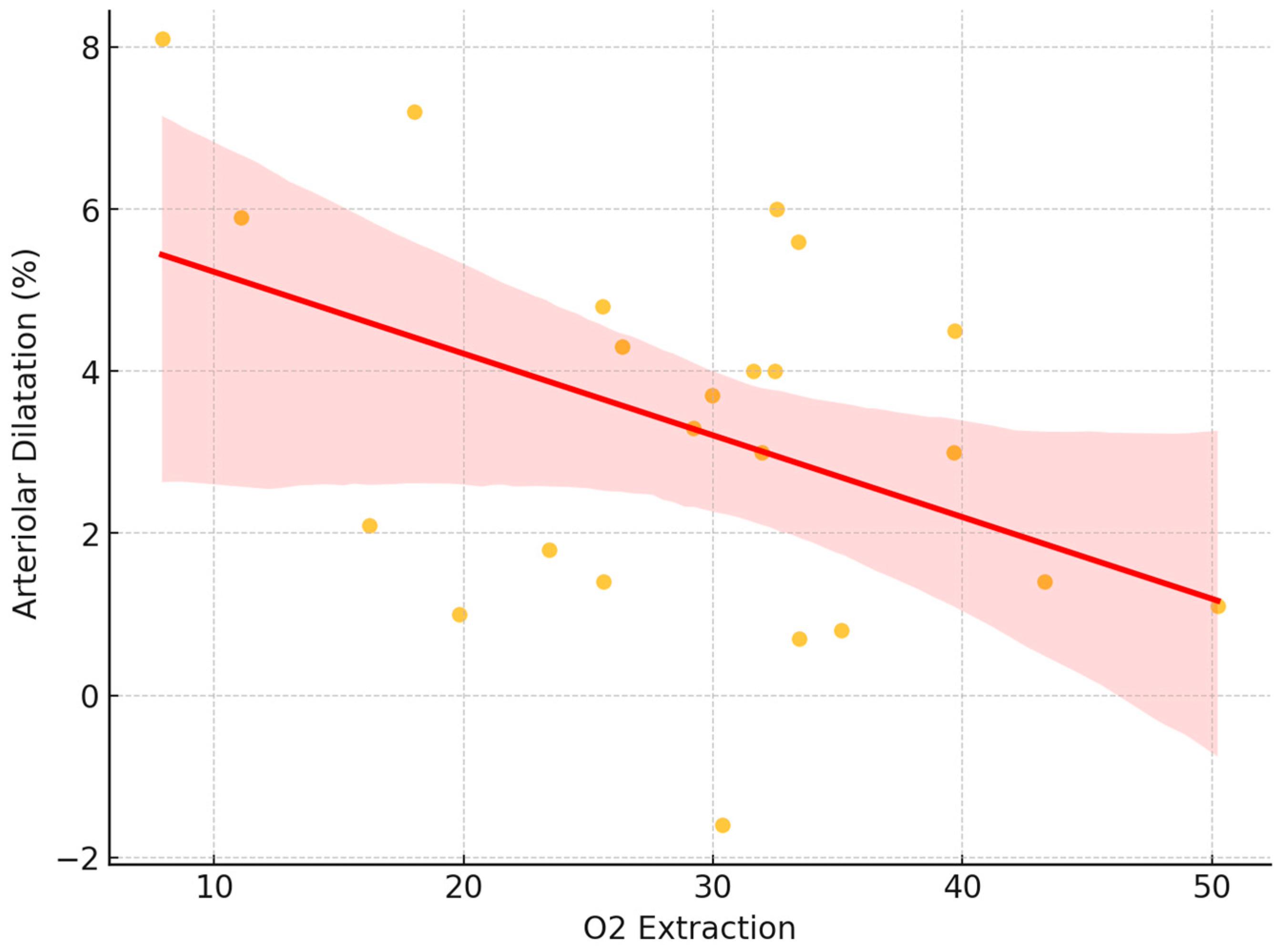
Disclaimer/Publisher’s Note: The statements, opinions and data contained in all publications are solely those of the individual author(s) and contributor(s) and not of MDPI and/or the editor(s). MDPI and/or the editor(s) disclaim responsibility for any injury to people or property resulting from any ideas, methods, instructions or products referred to in the content. |
© 2025 by the authors. Licensee MDPI, Basel, Switzerland. This article is an open access article distributed under the terms and conditions of the Creative Commons Attribution (CC BY) license (https://creativecommons.org/licenses/by/4.0/).
Share and Cite
Artemiev, D.; Valmaggia, C.; Tschuppert, S.; Kotliar, K.; Türksever, C.; Todorova, M.G. Retinal Vessel Flicker Light Responsiveness and Its Relation to Analysis Protocols and Static and Metabolic Data in Healthy Subjects. Biomedicines 2025, 13, 1201. https://doi.org/10.3390/biomedicines13051201
Artemiev D, Valmaggia C, Tschuppert S, Kotliar K, Türksever C, Todorova MG. Retinal Vessel Flicker Light Responsiveness and Its Relation to Analysis Protocols and Static and Metabolic Data in Healthy Subjects. Biomedicines. 2025; 13(5):1201. https://doi.org/10.3390/biomedicines13051201
Chicago/Turabian StyleArtemiev, Dmitri, Christophe Valmaggia, Scott Tschuppert, Konstantin Kotliar, Cengiz Türksever, and Margarita G. Todorova. 2025. "Retinal Vessel Flicker Light Responsiveness and Its Relation to Analysis Protocols and Static and Metabolic Data in Healthy Subjects" Biomedicines 13, no. 5: 1201. https://doi.org/10.3390/biomedicines13051201
APA StyleArtemiev, D., Valmaggia, C., Tschuppert, S., Kotliar, K., Türksever, C., & Todorova, M. G. (2025). Retinal Vessel Flicker Light Responsiveness and Its Relation to Analysis Protocols and Static and Metabolic Data in Healthy Subjects. Biomedicines, 13(5), 1201. https://doi.org/10.3390/biomedicines13051201






